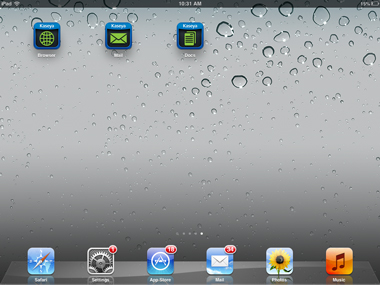Kaseya Launches BYOD Solution
Five months after acquiring Rover Apps, Kaseya has released a rebranded version of Rover's bring-your-own-device (BYOD) management technology for Kaseya's managed service provider and enterprise IT customers.
Kaseya bought Rover Apps in a burst of acquisition activity this summer. Insight Venture Partners announced a significant investment in Kaseya on June 24, bringing in new CEO Yogesh Gupta. A few weeks later on July 9, Kaseya acquired cloud and network monitoring solution vendor Zyrion Inc., with the Rover Apps acquisition coming July 16.
In an interview, Kaseya Chief Marketing Officer Loren Jarrett said those acquisitions, along with the Oct. 24 purchase of Office 365 Command, all fit with Gupta's vision for Kaseya. "What Kaseya does is we manage across everything that an IT department may be grappling with," Jarrett said.
The conversion of the Rover Apps BYOD solution addresses a relatively recent major requirement -- handling personal devices that employees need to use with corporate data.
"It's a challenge because employees don't want heavy-handed corporate management over their device. They don't want the corporation to be able to see what they're doing, read their data or control their device at all," she said. "At the same time, IT needs very strict controls over corporate data. They need to have the highest levels of security around corporate data and assets."
Kaseya rebranded and integrated the licensing of the Rover Apps technology as the Kaseya BYOD Suite. Unlike many mobile device management solutions, which require corporate control of an entire smartphone or tablet, the Kaseya BYOD solution relies on what are called "containerized" apps.
End users download three apps -- Browser, Docs and Mail -- on their iOS or Android devices and connect to a Kaseya BYOD Gateway. Users only need to follow corporate authentication requirements when accessing those apps, not when accessing the device.
"We're essentially moving the locus of endpoint control," said Jonathan Foulkes, vice president of Mobile Product Management for Kaseya and the former CEO and co-founder of Rover Apps. "We're moving the endpoint to be the secure containers for those applications."
 [Click on image for larger view.]
Users of Kaseya BYOD Suite see three apps on their devices -- Mail, Docs and Browser. Signing in with corporate credentials is only required when launching the apps, not when using the device itself.
[Click on image for larger view.]
Users of Kaseya BYOD Suite see three apps on their devices -- Mail, Docs and Browser. Signing in with corporate credentials is only required when launching the apps, not when using the device itself.
According to Kaseya, security for the containerized apps includes AES 256 encryption atop SSL encryption and complies with privacy standards including FINRA and FIPS 140-2.
To access either corporate mail or documents or to browse corporate Web sites securely, users authenticate against the Active Directory with a username and password. Foulkes said the frequency of that password authentication is set by policy -- for example, once every 24 hours. After briefer periods of inactivity, users can re-enter the app with a PIN.
Kaseya's Docs app connects with back-end data sources, such as Microsoft SharePoint, and the app includes a third-party Office and PDF editor. "We wanted to make sure that we had a full built-in Office editor suite in this secure container. This allows organizations to be guaranteed that if their employee is viewing or editing a document, it's all within the context of a secure, managed application. That it's not, 'Boy, I hope they don't put it in that crazy new editor they just downloaded from the Google Play Store,'" Foulkes said.
The back-end of the Kaseya BYOD Suite consists of a cloud-based relayer and a BYOD Gateway that is installed as a service on a PC or server in the customers' network. In this first version as a Kaseya-branded product, the BYOD Suite is integrated with Kaseya licensing, but management of the technology is through the rebranded gateway software -- not through regular Kaseya dashboards.
"Our very next deliverable in 2014 will be a single pane of glass where you'll be able to see and manage all of the mobility needs of an organization," Foulkes said.
The need to administer the solution from the gateway also means MSPs will need to monitor and manage their customers individually, rather than from a multi-customer dashboard. Foulkes noted that very little subsequent management is usually required after initial setup. For an administrator, he said, "Most of the work is the initial configuration of what things am I going to publish and what's my configuration. Once you complete these, you can have 100 new users join the system and there's no activity that needs to happen with the MSP."
Stephen Lawson, principal consultant with Bulletproof InfoTech, a Calgary, Alberta-based MSP and Kaseya customer, is very interested in Kaseya's new BYOD approach, although he hasn't tried it yet.
"Right now, with a lot of our BYODs, if they are uncompliant, they're getting their phones purged by us. This would save us from those messy moments where you just nuke the corporate data," Lawson said.
Of Bulletproof InfoTech's small and medium business customers, Lawson said he expects the larger organizations to be more interested. "The small businesses, they almost don't care. If they're only a 10-seat company, they have a pretty close relationship between the owner and the person who has the phone. Bigger customers are more concerned with unique processes and what happens if they have to terminate an employee or if the phone gets lost," Lawson said.
Posted by Scott Bekker on December 16, 2013